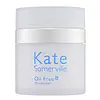What's inside
What's inside
 Key Ingredients
Key Ingredients

No key ingredients
 Benefits
Benefits

 Concerns
Concerns

 Ingredients Side-by-side
Ingredients Side-by-side

Water
Skin ConditioningIsocetyl Stearate
EmollientPentaerythrityl Tetracaprylate/Tetracaprate
EmollientC12-15 Alkyl Benzoate
AntimicrobialPolyamide-5
Skin ConditioningXylitylglucoside
HumectantAnhydroxylitol
HumectantXylitol
HumectantDipalmitoyl Hydroxyproline
Skin ConditioningPEG/PPG-18/18 Dimethicone
EmulsifyingBehenyl Alcohol
EmollientPullulan
Cetearyl Ethylhexanoate
EmollientSodium Polyacrylate
AbsorbentDimethicone
EmollientCyclopentasiloxane
EmollientButylene Glycol
HumectantTrideceth-6
EmulsifyingAlgae Extract
EmollientTriethanolamine
BufferingAhnfeltiopsis Concinna Extract
Skin ConditioningEthylhexylglycerin
Skin ConditioningPhenoxyethanol
PreservativeAdenosine
Skin ConditioningWater, Isocetyl Stearate, Pentaerythrityl Tetracaprylate/Tetracaprate, C12-15 Alkyl Benzoate, Polyamide-5, Xylitylglucoside, Anhydroxylitol, Xylitol, Dipalmitoyl Hydroxyproline, PEG/PPG-18/18 Dimethicone, Behenyl Alcohol, Pullulan, Cetearyl Ethylhexanoate, Sodium Polyacrylate, Dimethicone, Cyclopentasiloxane, Butylene Glycol, Trideceth-6, Algae Extract, Triethanolamine, Ahnfeltiopsis Concinna Extract, Ethylhexylglycerin, Phenoxyethanol, Adenosine
Water
Skin ConditioningNeopentyl Glycol Diheptanoate
EmollientCaprylic/Capric Triglyceride
MaskingCetearyl Alcohol
EmollientCocoglycerides
EmollientPropanediol
SolventGlycerin
HumectantCetyl Esters
EmollientDimethicone
EmollientTridecyl Neopentanoate
EmollientStearyl Alcohol
EmollientGlyceryl Stearate
EmollientErgothioneine
AntioxidantPanthenol
Skin ConditioningTocopheryl Acetate
AntioxidantPalmitoyl Dipeptide-10
Skin ConditioningKappaphycus Alvarezii Extract
Skin ConditioningTocopherol
AntioxidantTocotrienols
Skin ConditioningAloe Barbadensis Leaf Juice
Skin ConditioningAvena Sativa Bran Extract
AbrasiveHydrolyzed Hyaluronic Acid
HumectantAdenosine
Skin ConditioningSea Whip Extract
Skin ConditioningTripleurospermum Maritimum Extract
Skin ProtectingRosmarinus Officinalis Leaf Extract
AntimicrobialLavandula Angustifolia Flower/Leaf/Stem Extract
MaskingMentha Piperita Leaf Extract
Skin ConditioningPassiflora Incarnata Fruit Extract
Skin ConditioningAniba Rosaeodora Wood Extract
MaskingCamellia Sinensis Leaf Extract
AntimicrobialCananga Odorata Flower Extract
PerfumingCupressus Sempervirens Seed Extract
PerfumingFucus Vesiculosus Extract
EmollientPrunus Armeniaca Fruit Extract
Skin ConditioningJasminum Officinale Flower/Leaf Extract
MaskingVanilla Planifolia Fruit Extract
Skin ConditioningCitrus Aurantium Bergamia Fruit Extract
Skin ConditioningSantalum Album Wood Extract
PerfumingCoriandrum Sativum Seed Extract
Skin ConditioningCucumis Melo Cantalupensis Fruit Extract
AstringentCucumis Sativus Fruit Extract
EmollientPrunus Persica Fruit Extract
AbrasivePyrus Malus Fruit Extract
Skin ConditioningRose Extract
Skin ConditioningRubus Idaeus Fruit Extract
AstringentTetrahexyldecyl Ascorbate
AntioxidantCeteareth-20
CleansingPEG-40 Stearate
EmulsifyingSodium Acrylate/Sodium Acryloyldimethyl Taurate Copolymer
Emulsion StabilisingArachidyl Alcohol
EmollientElaeis Guineensis Oil
EmollientCetyl Alcohol
EmollientSorbitan Oleate
EmulsifyingIsohexadecane
EmollientXanthan Gum
EmulsifyingEthylhexylglycerin
Skin ConditioningPolysorbate 80
EmulsifyingDisodium EDTA
Potassium Sorbate
PreservativeCitric Acid
BufferingPhenoxyethanol
PreservativeSodium Benzoate
MaskingSorbic Acid
PreservativeWater, Neopentyl Glycol Diheptanoate, Caprylic/Capric Triglyceride, Cetearyl Alcohol, Cocoglycerides, Propanediol, Glycerin, Cetyl Esters, Dimethicone, Tridecyl Neopentanoate, Stearyl Alcohol, Glyceryl Stearate, Ergothioneine, Panthenol, Tocopheryl Acetate, Palmitoyl Dipeptide-10, Kappaphycus Alvarezii Extract, Tocopherol, Tocotrienols, Aloe Barbadensis Leaf Juice, Avena Sativa Bran Extract, Hydrolyzed Hyaluronic Acid, Adenosine, Sea Whip Extract, Tripleurospermum Maritimum Extract, Rosmarinus Officinalis Leaf Extract, Lavandula Angustifolia Flower/Leaf/Stem Extract, Mentha Piperita Leaf Extract, Passiflora Incarnata Fruit Extract, Aniba Rosaeodora Wood Extract, Camellia Sinensis Leaf Extract, Cananga Odorata Flower Extract, Cupressus Sempervirens Seed Extract, Fucus Vesiculosus Extract, Prunus Armeniaca Fruit Extract, Jasminum Officinale Flower/Leaf Extract, Vanilla Planifolia Fruit Extract, Citrus Aurantium Bergamia Fruit Extract, Santalum Album Wood Extract, Coriandrum Sativum Seed Extract, Cucumis Melo Cantalupensis Fruit Extract, Cucumis Sativus Fruit Extract, Prunus Persica Fruit Extract, Pyrus Malus Fruit Extract, Rose Extract, Rubus Idaeus Fruit Extract, Tetrahexyldecyl Ascorbate, Ceteareth-20, PEG-40 Stearate, Sodium Acrylate/Sodium Acryloyldimethyl Taurate Copolymer, Arachidyl Alcohol, Elaeis Guineensis Oil, Cetyl Alcohol, Sorbitan Oleate, Isohexadecane, Xanthan Gum, Ethylhexylglycerin, Polysorbate 80, Disodium EDTA, Potassium Sorbate, Citric Acid, Phenoxyethanol, Sodium Benzoate, Sorbic Acid
Ingredients Explained
These ingredients are found in both products.
Ingredients higher up in an ingredient list are typically present in a larger amount.
Adenosine is in every living organism. It is one of four components in nucleic acids that helps store our DNA.
Adenosine has many benefits when used. These benefits include hydrating the skin, smoothing skin, and reducing wrinkles. Once applied, adenosine increases collagen production. It also helps with improving firmness and tissue repair.
Studies have found adenosine may also help with wound healing.
In skincare products, Adenosine is usually derived from yeast.
Learn more about AdenosineDimethicone is a type of synthetic silicone created from natural materials such as quartz.
What it does:
Dimethicone comes in different viscosities:
Depending on the viscosity, dimethicone has different properties.
Ingredients lists don't always show which type is used, so we recommend reaching out to the brand if you have questions about the viscosity.
This ingredient is unlikely to cause irritation because it does not get absorbed into skin. However, people with silicone allergies should be careful about using this ingredient.
Note: Dimethicone may contribute to pilling. This is because it is not oil or water soluble, so pilling may occur when layered with products. When mixed with heavy oils in a formula, the outcome is also quite greasy.
Learn more about DimethiconeEthylhexylglycerin (we can't pronounce this either) is commonly used as a preservative and skin softener. It is derived from glyceryl.
You might see Ethylhexylglycerin often paired with other preservatives such as phenoxyethanol. Ethylhexylglycerin has been found to increase the effectiveness of these other preservatives.
Phenoxyethanol is a preservative that has germicide, antimicrobial, and aromatic properties. Studies show that phenoxyethanol can prevent microbial growth. By itself, it has a scent that is similar to that of a rose.
It's often used in formulations along with Caprylyl Glycol to preserve the shelf life of products.
Water. It's the most common cosmetic ingredient of all. You'll usually see it at the top of ingredient lists, meaning that it makes up the largest part of the product.
So why is it so popular? Water most often acts as a solvent - this means that it helps dissolve other ingredients into the formulation.
You'll also recognize water as that liquid we all need to stay alive. If you see this, drink a glass of water. Stay hydrated!
Learn more about Water